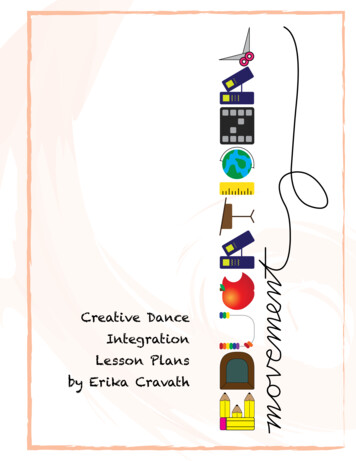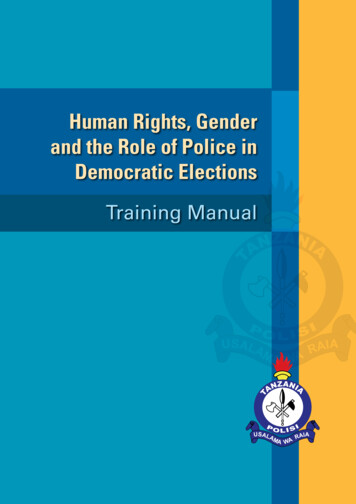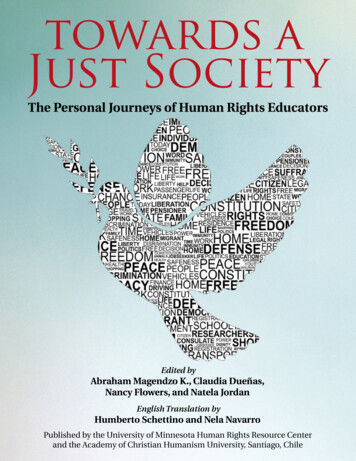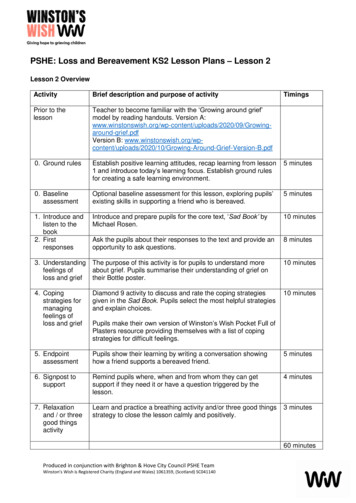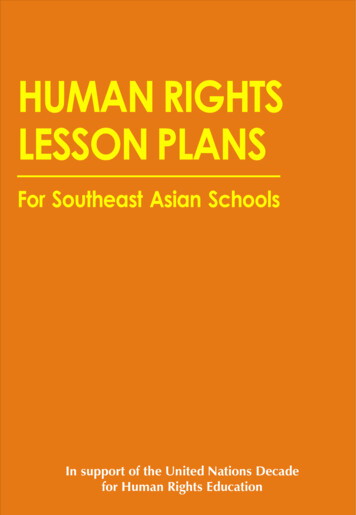
Transcription
HUMAN RIGHTSLESSON PLANSFor Southeast Asian SchoolsIn support of the United Nations Decadefor Human Rights Education
HUMAN RIGHTS LESSON PLANSforSoutheast Asian SchoolsAsia-Pacific Human Rights Information CenterOctober 2003
Human Rights Lesson Plans for Southeast Asian Schoolswas published by the Asia-Pacific Human Rights Information Center1-2-1-1500, Benten, Minato-ku, Osaka 552- 0007 JapanCopyright Asia-Pacific Human Rights Information Center, 2003All rights reserved.ISBN: 974 -9731-1-2Printed and bound by Reuan KaewBangkok, Thailand
CONTENTSPageAcknowledgmentvMessagesYoshio KawashimaFe A. HidalgoIntroductionDeveloping Lesson Plans for Human Rightsviiixxi3A. Human Rights Curricular Framework1.2.3.4.5.6.CambodiaIndonesiaMalaysiaThe PhilippinesThailandVietnam151617182021B. Lesson PlansI. Primary School Level1. Living in a Clean Environment (Science)2. I’m Entitled to Leisure (Social Studies,Physical Education and Health)3. Care and Protection (Moral Education, Social Studies)4. I’m Involved (Moral Education)5. Drug Abuse (Social Studies)6. Right to Education (Moral Education)7. Child Labor (Social Studies)8. My Opinion (Civic Education, Social Studies)9. Our Willingness to Share(Civic Education, Social Studies)10. Work During the Dry Season(Social Studies, Science, Home Economics)25283236404449525760
PageII. Secondary School Level1. Human Dignity (Moral Education, Civic Education) 652. Graft and Corruption (Moral Education)713. Life Is Meaningful (Moral Education)764. Freedom from Discrimination (Social Studies)805. Migrant Workers (Moral Education, Social Studies)856. Street Children (Civic Education)907. National Budget and Taxation(Economics, Social Studies)978. Legal Procedures (Social Studies)1039. Development and Human Rights(Local Studies, Economics)10810. Human Rights are Universal (Social Studies)114C. Reference Materials1. Universal Declaration of Human Rights2. Convention on the Rights of the Child3. Introduction to Human Rights Terminology123131164Appendices1. Southeast Asian Writing Workshop Participants2. Regional Review Team3. Photos Human Rights Lesson Plans iv 171178180 for Southeast Asian Schools
ACKNOWLEDGMENTWe would like to acknowledge the support of so many individuals andinstitutions in the preparation of this publication.We thank the participants of the Southeast Asian Writing Workshop onDeveloping Human Rights Teaching Guides (SEA Writeshop) whose workprovided the basic materials of this publication. At the same time, weexpress our apologies for not indicating authorship of the lesson plans.This was done in order to give a Southeast Asian, rather than national,identity to the lesson plans. Due to the number of the SEA writeshopparticipants, we cannot cite them individually in this Acknowledgement.A complete list, therefore, is in the Appendices.We thank the following members of the Regional Review Team for theirpatience and hard work in revising the lesson plans:1. Dr. Nguyen Thanh HoanMinistry of Education and Training, Vietnam2. Ms. Chin YahanMinistry of Education, Youth and Sport, Cambodia3. Dr. Valai na PombejrAsia-Pacific Network for International Educationand Values Education (APNIEVE), Thailand4. Dr. Sirilus BelenMinistry of Education and Culture, Indonesia5. Prof. Dr. Chiam Heng KengHuman Rights Commission of Malaysia, Malaysia6. Ms. Zaida T. AzcuetaDepartment of Education, Philippines.We are grateful to Dr. Valai na Pombejr for proofreading this publication,101 Freelance for the layout, Ms. Rungtip Imruangruang and the CatholicCommission for Justice and Peace, Thailand for the administrative support. Human Rights Lesson Plans v for Southeast Asian Schools
We acknowledge the support provided by Mr. Jefferson R. Plantilla of theAsia-Pacific Human Rights Information Center (HURIGHTS OSAKA) andMs. Nerissa L. Losaria of the Department of Education (Philippines) infinalizing the lesson plans.We thank the United Nations Office of the High Commissioner forHuman Rights and the United Nations Children’s Fund - Canada office(UNICEF - Canada) for the permission to use the plain language version ofthe Universal Declaration of Human Rights, the Convention on the Rightsof the Child, and an introduction to human rights terminology as referencematerials in this publication.We acknowledge the drawings, illustrations and photographs fromCambodia, Vietnam and Thailand that broke the monotony of the texts.Finally, we thank the Friedrich Naumann Foundation through its regionaloffice in Bangkok for funding a meeting of the Regional Review Team andthe printing of this publication. We thank Mr. Uwe Johannen, the regionaloffice head, for his full support for the publication, and Ms. WallayaPinprayoon for the administrative work. Human Rights Lesson Plans vi for Southeast Asian Schools
MESSAGETeachers are the frontline workers in the field of education . On theirshoulders, we put the responsibility of helping our students prepare fortheir future. It is thus fitting to recognize the important role of the teachersand give them the support needed to pursue their tasks.The situation of the teachers is a major consideration in our effort in theAsia-Pacific Human Rights Information Center (HURIGHTS OSAKA) topromote the teaching of human rights in schools. Unless the teachers aresupported, any program on human rights education in schools is bound tofail.We therefore appreciate the support given by educators to the 2001 Southeast Asian Writing Workshop on Developing Teaching Guides on HumanRights (SEA writeshop), which produced the lesson plans adapted in thispublication. We thank the participants as well as our partners (thePhilippine Department of Education, the Commission on Human Rightsin the Philippines, and the Southeast Asian Fund for Institutional and LegalDevelopment) for sharing with us their vision, commitment and resourcesin holding the SEA writeshop.We finally have a set of human rights lesson plans aimed primarily, thoughnot exclusively, for Southeast Asian teachers. We now have the task ofmaking these lesson plans used by teachers inside Southeast Asian classrooms.We hope that teachers will find the content and method in the lesson planssuitable to their needs and appropriate to their students. We also hope thatthese lesson plans will inspire teachers and other educators to be moreinvolved in human rights education.We deeply appreciate the support provided by the Friedrich NaumannFoundation for the printing of this publication. Human Rights Lesson Plans vii for Southeast Asian Schools
Finally, in offering this publication to the teachers in Southeast Asia andbeyond we also contribute to the fulfillment of the goals of the UnitedNations Decade for Human Rights Education (1995-2004). This UN Decadehas become our over-all framework in promoting human rights educationin the region.Prof. Yoshio KawashimaDirectorHURIGHTS OSAKAJapan Human Rights Lesson Plans viii for Southeast Asian Schools
MESSAGEHuman rights education translates abstract human rights principles intopractical classroom experiences. The human rights teaching exemplars weintroduced in our Philippine public schools serve as teaching tools in integrating human rights concepts and values in all learning areas - Mathematics, Science, Communication Arts (Filipino and English) andMAKABAYAN (Social Studies, Music, Arts, Physical Education, Technologyand Livelihood Education and Values Education). In these exemplars,human rights concepts and values are naturally linked with our prescribedlearning competencies in the basic education curriculum.Instructional materials are very essential in ensuring that human rightseducation serves its very purpose of inculcating respect for the dignity ofthe person and awareness of responsibilities as national and global citizens.The Southeast Asian Writing Workshop on the Development of HumanRights Teaching Guides was initiated by the Department of Education,the Commission on Human Rights in the Philippines, and HURIGHTSOSAKA to share the Philippine experience on instructional and materialdevelopment to our Southeast Asian counterparts in education and topromote human rights education in the region. It is expected that theteaching exemplars which present the human rights education continuumin a manner that transcends cultural, religious and other diversities willbe utilized in Southeast Asian schools. It will help us educate the childrenwe will be proud to have in the next generation.The objectives of human rights education are long-term in nature and anymanifestation of behavioral change may not be immediately seen andmeasured in the classroom. This will later be manifested in relationshipwith other people as our children grow and face the real and challengingworld. Human rights education, therefore, teaches not only basic humanand child rights but also responsible citizenship and action, democracy,love for freedom, national and global consciousness, sensitivity towardswomen and children issues, environmental protection, and sustainable Human Rights Lesson Plans ix for Southeast Asian Schools
development. The articulation of these human rights education objectivesis witnessed in the Southeast Asian teaching exemplars. We therefore seekthe support of education ministries in the region in ensuring that these areutilized in Southeast Asian classrooms/schools. There is always theenduring task to promote human rights education that eventually redoundsto better relationship among people and positive outlook towards theworld we live in.The Southeast Asian teaching exemplars constitute a big step in realizingour vision for human rights education.Fe A. Hidalgo, Ph.D.Undersecretary for Program and ProjectsDepartment of EducationPhilippines Human Rights Lesson Plans x for Southeast Asian Schools
INTRODUCTIONThis publication is an initial attempt at developing human rights teachingguides for Southeast Asian schools. It is based on the experience ofeducators in the sub-region in teaching human rights. It is the result of acontinuing partnership among educators and institutions in Southeast Asia.Collaboration, therefore, is a key characteristic of this publication.This publication is a contribution to the realization of the objectives of theUnited Nations Decade for Human Rights Education (1995-2004) [UNDecade]. The UN Decade supports the development of human rightsteaching materials. The UN Decade also promotes collaboration amonginstitutions as an important means of undertaking human rights educationprograms.The story of this collaboration started in a series of activities on humanrights education in schools initiated in Southeast Asia in late 1990s. Thefirst activity was a 1998 consultation workshop (Surabaya workshop).1 Itreviewed the human rights education in schools programs in severalSoutheast Asian countries, the problems encountered and opportunitiesthat exist. The participants2 identified a number of areas that require improvement: Teaching methodology – development of process and experienceoriented methodologies in teaching human rights. Teaching materials – development of human rights teachingmaterials for classroom teachers. Approaches to human rights education – exploration of ways ofteaching human rights other than the values-approach. Popularization of human rights concepts – making human rightsprinciples and standards easy to understand by using ordinary language(rather than the United Nations human rights language), and discussingconcrete human rights violations or problems in society and in people’sdaily lives. Human Rights Lesson Plans xi for Southeast Asian Schools
Teacher empowerment – facilitating the empowerment of teachersthrough teacher training and other means that will enable them to teachinnovatively, and create better teaching environment. Their empowermentmust deal with “ways in which they can better relate to the educationbureaucracy and contribute to their sense of fulfillment in teaching. Thisalso includes giving professional credit for completing teacher trainingprograms on human rights education, and providing incentives in teachinghuman rights.” Content of human rights education – widening the scope of humanrights education to include such matters as the “political concept of theState, and the inter-connection of peace, development, environment,gender, ethnicity and other issues with human rights as a broad [conceptual] umbrella (payong concept).”3At the end of the workshop, the participants agreed to develop a guidematerial for the promotion of human rights education in the subregion.The Southeast Asia Pilot Teacher Training Workshop on Human Rights4held on 26-29 April 1999 in Bali, Indonesia followed the Surabaya workshop. This training workshop (Bali training) had the following agenda: Human rights concept and vision, which reviewed the human rightssituation and issues, national histories, and sectoral human rights concerns(such as those of women, children, minorities, etc.). Human rights education and the school curriculum, which included(i)an update on human rights education work,(ii)discussion on the role of schools in promoting human rightsin society,(iii) profiling of human rights advocates (teachers and students),and(iv) developing model human rights curriculums. Teaching methodology, which involved making lesson plans, modules,and teaching guides. Dissemination mechanism for training output (within and outsidethe school system). Evaluation of human rights education programs and activities.The participants held teaching demonstration sessions in a public highschool in Bali to test lesson plans made during the workshop. Finally, theparticipants agreed on follow-up activities that would “promote networking and continuous mutual support at the national level.” They agreed, Human Rights Lesson Plans xii for Southeast Asian Schools
among others, on the following: Holding a writing workshop (writeshop) for facilitators. Developing human rights education modules for facilitators andteachers.5The participants recognized the value of writeshop as a means of improvingskill in writing human rights lesson plans.The Surabaya workshop broadly expressed the need for a training ondeveloping human rights lesson plans when the participants listed thedevelopment of human rights teaching materials for classroom teachersas an area that requires improvement. The Bali training, on the other hand,set the stage for the holding of a training activity along this line.Representatives of Indonesia, the Philippines and Thailand planned theprogram of a Southeast Asian writeshop.Twenty-six participants composed of teachers, education researchers,curriculum developers and NGO workers from Cambodia, Indonesia,Malaysia, the Philippines, Thailand and Vietnam gathered in the Philippineson 19-27 June 2001 for a nine-day Southeast Asian Writing Workshop onDeveloping Human Rights Teaching Guides (SEA writeshop).6The general objective of the SEA writeshop is to “develop human rightsteaching guides for Southeast Asian schools.”It specifically aimed at the following objectives: To formulate Southeast Asian human rights education vision andmission. To review human rights standards and principles in order to identifycore human rights concepts for basic education. To reexamine linkages between human rights and Southeast Asiancultures in order to help translate human rights concepts into educationalmaterials. To train on how to relate human rights lesson plans to the existingschool curriculum. To identify various strategies for infusion of human rights in theformal education curriculum. To identify programs for extra and co-curricular activities and/or Human Rights Lesson Plans xiii for Southeast Asian Schools
human rights community-based activities. To prepare an action plan regarding strategy in regional lobby forhuman rights education. To strengthen linkages among educators in Southeast Asia involvedin human rights education in schools.During the nine-day period, the writeshop participants had the followingprogram: Review of human rights education programs, human rights principles, human rights education approaches, strategies and methods; andformulation of ASEAN Vision and Mission for human rights education. Writing of human rights teaching guides. Teaching demonstration using the teaching guides developed. Planning for follow-up activities.The participants wrote their respective country human rights curricularframeworks and lesson plans. They also agreed on the suggestion to publishthe lesson plans, and to undertake training on how to use them.Subsequently, a Regional Review Team (Review Team) was formed composedof leading representatives of the six Southeast Asian countries. The ReviewTeam had the following tasks: Finalize the set of lesson plans and other materials to be included inthe publication. Review the final draft of the lesson plans as an editorial team. Propose a plan for the distribution of the publication to SoutheastAsian educators/schools.The Review Team met twice in Bangkok in 2002. It selected the lessonplans to be included in the publication, discussed how they can be improved,and worked on the lesson plans themselves. Drafts of the lesson plans werecirculated to the review team members after the second meeting for theirrespective suggestions and comments.Due to the problem of making the draft lesson plans available on time,the classroom testing of the primary school lesson plans was done only inCambodia. The schools in other countries were already closed for thesummer vacation (April-May 2003) and thus classroom testing was notpossible. A group of Thai teachers had the chance to review the lessonplans however. Human Rights Lesson Plans xiv for Southeast Asian Schools
The final version of the lesson plans incorporated the suggestions and comments of the review team members. Brief but substantive discussions onspecific human rights concepts were added.This process completed the cycle of collaboration among Southeast Asianeducators in producing a set of human rights teaching materials. A newcycle of collaboration is bound to begin now that this publication is done.Consequently, a cycle of adaptation and translation of this publication intothe languages of the countries involved and the training of their teachertrainers will develop as a step toward further promotion of human rightseducation in Southeast Asian schools.EndnotesThe Indonesian National Commission for Human Rights (KOMNASHAM), the Center forHuman Rights Studies of Universitas Surabaya (Surabaya city, Indonesia) and the AsiaPacific Human Rights Information Center (HURIGHTS OSAKA) jointly organized thisconsultation workshop.There were participants from Cambodia, Indonesia, Malaysia, the Philippines and Vietnam.Payong is a Malay word for umbrella. For the full report on this consultation workshopvisit lKOMNASHAM, the Center for Human Rights Studies of Universitas Surabaya andHURIGHTS OSAKA again joined hands in organizing the Bali training. It was financiallysupported by the Southeast Asian Fund for Legal and Institutional Development (SEAFILD).Educators from Cambodia, Indonesia, the Philippines, Thailand and Vietnam attendedthis training workshop. For the full report on this training workshop, please refer to volumethree of the Human Rights Education in Asian Schools (HURIGHTS OSAKA: 2002) orvisit: www.hurights.or.jp/hreas/3/14osaka.htmThe Department of Education (Philippines), the Commission on Human Rights (Philippines),and HURIGHTS OSAKA jointly organized the SEA writeshop. Financial support was partlyprovided by SEAFILD.1.2.3.4.5.6. Human Rights Lesson Plans xv for Southeast Asian Schools
DEVELOPING LESSON PLANSFOR HUMAN RIGHTS
DEVELOPING HUMAN RIGHTSLESSON PLANSHuman rights lesson plan development is a challenging task. It challengesthe teachers to mix standard educational tools with the practical applicationof human rights concepts. It provides a new dimension in discussingsubjects in the school curriculum.There are two levels of preparation of the Southeast Asian human rightslesson plans. The first level is the writing of lesson plans during the Southeast Asian Writing Workshop on Developing Human Rights TeachingGuides (SEA writeshop) in 2001. The second level is the review and editingdone by the Regional Review Team in 2002. There are distinct processesinvolved in each level.Writeshop processThe writeshop process in developing human rights lesson plans has twomain parts: creating a human rights curricular framework, and writingthe lesson plans.The human rights curricular framework is a multi-year, multi-subjectoverview of the human rights education program. It consists of three majorcomponents - issues or problems, human rights concepts, and core values.During the SEA writeshop, the country delegations developed theirrespective human rights curricular frameworks covering primary andsecondary schools. These human rights curricular frameworks follow aprogressing pattern. They start with issues, human rights concepts andcore values that relate to the Self, then to the Family, Community, Country,Region and finally the Globe/World. In this way, the issues and humanrights concepts are correspondingly becoming more complicated as the“world” of the students becomes bigger. The stages (Self, Family,Community, Country, Region, World) correspond to different year levels.Primary school may cover the stages of the Self to Country, while secondary Human Rights Lesson Plans 3 for Southeast Asian Schools
school may cover the rest.The general guide is that the issues are appropriate to the level ofdevelopment and experience of the students. There can be differentperceptions of the relevant issues for the different stages. The issues mayalso be similar in several stages. Development and environmental issues,for example, may be relevant at the stage of the community as well ascountry and region. Thus there is no set issues that can be linked exclusivelyto each stage. The determination of issues is largely subject to the decisionof the people developing the human rights curricular framework.The core values refer to the existing set of values that the school curriculumrequires the students to learn. These values may be drawn from the moralstudies, civic education and any other relevant subjects in the schoolcurriculum. The identification of these values is important in linking thehuman rights curricular framework to the general school curriculums.The values may be similar to the cultural, social, religious/spiritual valuesof the countries in Southeast Asia.The human rights curricular framework therefore is a means of planningthe whole human rights education program in primary and secondaryschools. It provides a guide on how the human rights concepts can beintroduced at each year level. It aims to give the teachers and schooladministrators a perspective on how human rights concepts can be taughtin the existing school curriculum.A more complete human rights curricular framework may include a listingof corresponding subjects relevant to the issues, human rights conceptsand core values per year level.With the completion of the human rights curricular framework, the nextstep is the development of the human rights lesson plans.As a response to the issue of relevance of human rights education to thedaily lives of the students, a primary step in developing the human rightslesson plans is the identification of issues that are more or less the concernsof the students. The question is: what issues would students eitherordinarily or possibly encounter in their daily lives? The answers to thisquestion vary from one level of students to another, from school to school,from one background of students to another. Thus the issues taken up in Human Rights Lesson Plans 4 for Southeast Asian Schools
human rights lesson plans vary to a great degree.From a national perspective, this question can be answered through areview of the current issues faced by the country. Answers may rangefrom poverty to drug abuse to domestic violence.During the SEA writeshop, the delegations from the six Southeast Asiancountries came up with several common issues such as: child abuse(including child labor), discrimination based on ethnicity, gender andeconomic standing, domestic violence, drug abuse, environmentaldegradation, health problems, and poverty. These issues reflect to a largeextent both the local contexts and the national situations in Southeast Asia.These issues also prove the commonality of some concerns that are takenup in the different human rights education in schools programs in Southeast Asia.The second component in the development of human rights lesson plansis the link to the existing school curriculum. There is a need to make surethat the contents of the lesson plans are linked to the learning areas of theschool curriculum and would enrich the teaching of the relevant subjects.While human rights issues are generally seen as appropriate in socialscience subjects (history, language, social studies, moral studies andeconomics), there is now a trend toward using mathematics, and naturalscience subjects for this purpose. Thus lesson plans can cover almost allsubjects including physical education subject in the school curriculum.During the SEA writeshop, one country delegation included biology andhealth and science subjects for their human rights lesson plans.Extra-curricular activities are included in the application of the humanrights concepts learned inside the classroom. They therefore form part ofthe human rights lesson plans.The relevant core values identified in the human rights curricular framework are incorporated into the lesson plans These values are assumed tobe required contents of the subjects in the school curriculum. The identification of relevant core values has the purpose of strengthening the linkof the human rights less on plans to the school curriculum. The discussionof issues and related human rights concepts becomes easier for teachers Human Rights Lesson Plans 5 for Southeast Asian Schools
when they are linked to the values included in their respective subjects.Regional review processIn order to assure quality, adaptability and wider use of the lesson plansin Southeast Asian countries, a Regional Review Team (Review Team)was formed to do the following tasks:a. Finalize the set of lesson plans and other materials to be includedin the publication;b. Review the final draft of the lesson plans as an editorial team;c. Decide on the plan for the distribution of the publication to Southeast Asian educators/schools.The Review Team agreed to adopt the following general guidelines:1. Curricular frameworkThe basic human rights curricular framework for the primary andsecondary school levels adopted in the SEA writeshop was used by theReview Team in reviewing the lesson plans. The lesson plans cover primaryand secondary schools. For each level, the lesson plans are further classifiedinto lower and upper levels. Thus for the primary school, there are lowerand upper primary school lesson plans. Likewise, there are lower andupper secondary school lesson plans. This system provides flexibility inthe use of the lesson plans within each level. The use of the lesson plansvaries according to the definition of the lower and upper primary andsecondary schools in the country. The Review Team also recognized thatprimary school-level lesson plans might be used for secondary school level.2. Lesson plan formatThe lesson plan format adopted in the SEA writeshop was retained inreviewing and editing draft lesson plans. The lesson plan follows the 4Asapproach (Activity, Analysis, Abstraction and Application). For theprimary school lesson plans, however, the subtitles referring to Activity,Analysis, and Abstraction are not included to make the lesson plans lookmore simple.The final lesson plan format has a few additional parts to make the issuesand human rights concepts of the lesson plans more clear. See Annex 1for the final format of the lesson plan. Human Rights Lesson Plans 6 for Southeast Asian Schools
A note at the beginning of the lesson plan briefly explains the issues aswell as human rights involved. It emphasizes their importance andrelevance to the students. Another note at the end of the lesson planprovides additional explanation or information relevant to the humanrights involved.The Review Team made sure that the different parts of the lesson plansare consistent with each other.3. IssuesThe issues in the lesson plans were identified using the SEA writeshophuman rights curricular frameworks. Issues that are common among thesix countries’ human rights curricular frameworks were included alongwith those that are considered to be generally relevant to the subregion.Each lesson plan focuses on a single issue relating to as much as possibleone human rights concept.4. Human rights conceptsHuman rights concepts are presented in the form of a) original provisionsof international human rights instruments (included in the list of resourcesof the lesson plan), b) in simple, summarized form in the “Abstraction”portion of the lesson plans, and also (in certain cases) in the c) final note ofthe lesson plan. To make the human rig
Developing Lesson Plans for Human Rights 3 A. Human Rights Curricular Framework 1. Cambodia 15 2. Indonesia 16 3. Malaysia 17 4. The Philippines 18 5. Thailand 20 6. Vietnam 21 B. Lesson Plans I. Primary School Level 1. Living in a Clean Environment (Science) 25 2. I’m Entitled to Leis

